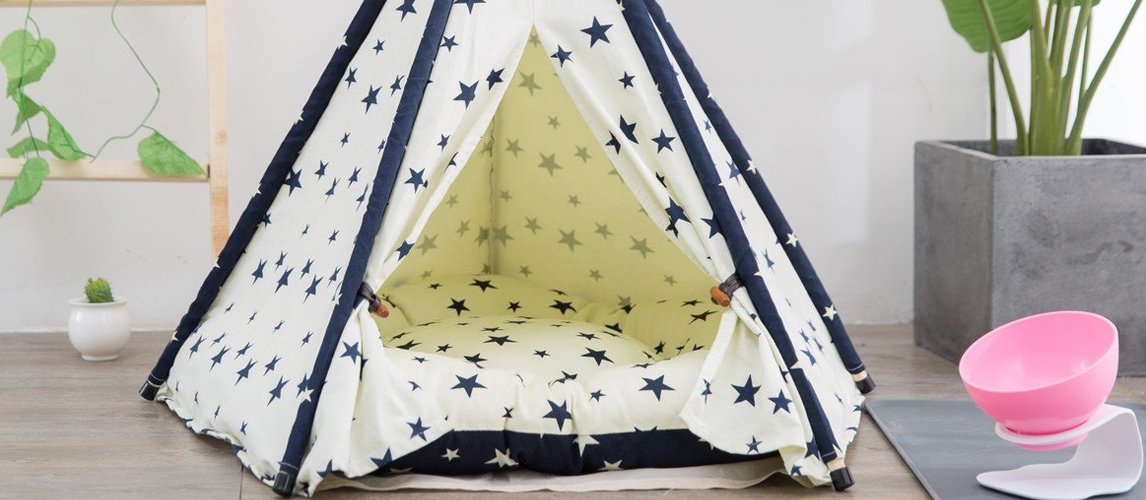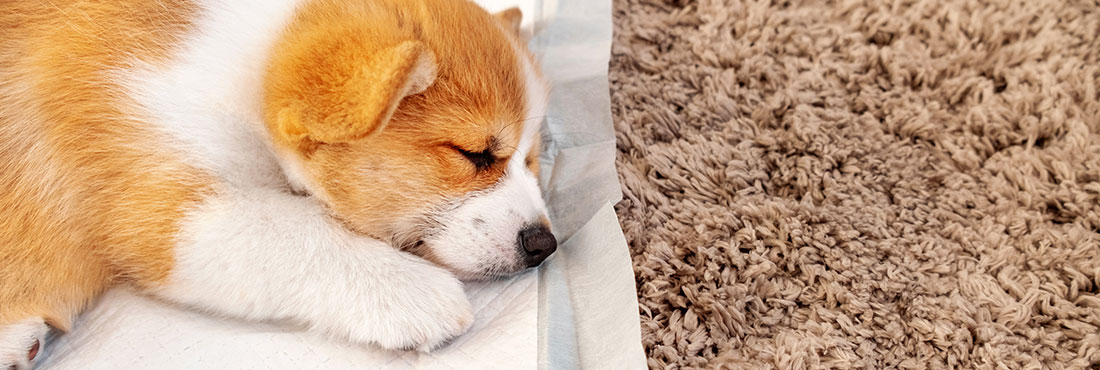While peeing indoors is usually associated with puppies, it’s no secret that sometimes a full-grown dog keeps peeing in the house. No matter what your situation, it can be really frustrating and even stop you from being able to bond with your dog. It’s also incredibly unhygienic and can build up to deeper, long-term behavioral issues if it isn’t addressed as soon as possible.
Suffice to say, to stop your dog peeing inside, it’s going to take a lot of patience, time and effort – but it’s completely worth it. Below, we break down the reasons why your dog might be peeing in the house and give you a complete breakdown in how to stop a dog from urinating indoors. Read on, to find the cause and nip the issue in the bud!
Related Post: Carpet Cleaners for Dog Urine
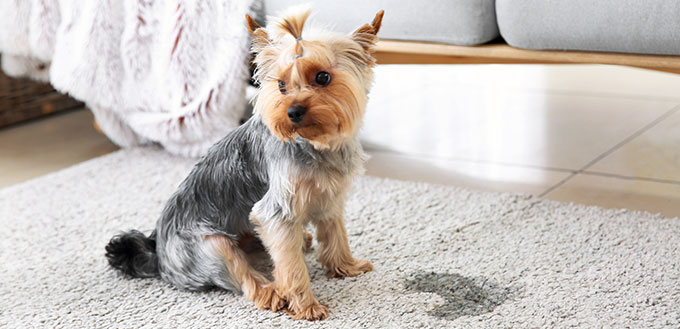
Why Do Dogs Pee in the House?
They’re Very Young
This one may seem a little obvious, but it can also surprise new dog owners to discover just how often a puppy needs to pee. And, without any training or guidance, or any knowledge that they’re even doing anything wrong, they will often go for a pee in the house.
Dog Marking in House
This is another common reason for why your dog is urinating indoors. It stems from their territorial instinct to protect what’s theirs and is essentially a way or warding off other animals. You can usually tell the difference between this type of indoor peeing from your dog and other types by the fact that they will sniff around for an extended period of time, first. They will also, usually, choose the same spots to mark – leaving you very frustrated with regular clean-ups.
Medical Reasons for Your Dog Peeing in the House
If your dog has started peeing in the house suddenly, then it may be a sign of an underlying medical issue. Ranging from short-term problems such as a urinary tract infection (UTI) and gastrointestinal distress, through to a serious condition such as cancer or bowel and genital disorders, you will need to make an appointment with your vet to rule out medical problems.
Behavioral Causes of Dog Peeing in the House
If your puppy has been housetrained, or your dog has had all medical causes ruled out, it’s time to look into possible behavioral reasons why your dog is urinating around the house. While many of these come from different causes, the main theme running through these behavioral issues is raised levels of anxiety, fear and stress.
Examples of this might including peeing as you step through the door to greet them – this is simply a sign of submissive urinating. Another might be through experiencing a new sensation, sound or anything else that might overload their senses, in which case they will urinate.
You can usually tell whether a dog is urinating due to excitement or anxiety because they will not be in their usually peeing position – cocking a leg or crouching their back legs to a near-sitting position. They may also show you their stomachs or be trying to lay as low as possible, often with their ears back and head down, with their tail between their legs.
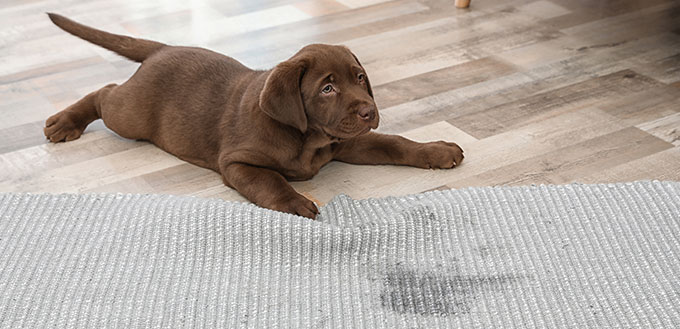
How to Stop a Dog from Peeing in the House
The biggest and most important factor to stop a dog peeing in the house is to remain calm and patient at all times. No matter what the cause of the urinating is, they will look to you for guidance. Never shout or scold your dog for urinating indoors – this will only make your dog fearful of you and lead to broken trust. Instead, try to live by this guidance to help stop your dog from peeing indoors.
Get Medical Advice
First and foremost, ask for advice from your vet. Identifying the trigger for the urination is essential to retraining and setting things right. This is especially true in cases of older dogs and dogs who are suddenly peeing in the house, as they may have an underlying medical condition. A vet will also have the most up-to-date advice regarding house training a puppy and give general advice.
Stop Dogs from Marking Indoors
If you’re wondering how to stop a dog from urinating indoors due to their marking behaviors, you’ll be pleased to know that the problem can often be resolved fairly quickly. It does, however, require a lot of care and attention from yourself:
- Clean up any favorite patches thoroughly, using a dog-friendly cleaner. Enzymic cleaners are ideal as they can mask the scent that is so appealing to your dog.
- Block off certain areas that your dog frequents in order to pee. Use dog gates or play pens to keep your dog away from areas that they are likely to urinate in.
- You can use a loud noise to startle your dog if you notice that they are marking in the house. They will quickly associate the unpleasant sound with their marking and soon stop.
- Always reward good behavior. If your dog is prone to marking, then make peeing outside the absolute best thing in the world – use a positive tone and lots of dog treats every time they urinate outdoors. They’ll soon associate the outdoor peeing with good reactions and prefer to go there, instead.
Housetrain Puppies
If your puppy keeps peeing indoors, it’s likely to stem from the fact that they simple don’t know any better. In these cases, training is absolutely vital. Use lots of rewards and take your puppy outside regularly – especially after they have eaten or had a drink. Try to keep to the same routine in order to help guide them into appropriate toilet times.
You may also like our review of the Best Indoor Dog Potty.
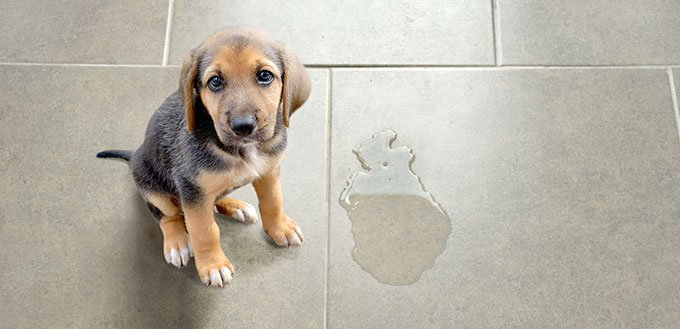
How to Stop Submissive Urination
Submissive urination will likely occur when something new or exciting is happening, and you’ll be pleased to know that most dogs grow out of this by the time they’re a year old, even without additional training. However, there’s no harm in helping things along.
Start by ignoring your dog when you enter your house. Set your things down and then head straight outside – your puppy or dog will always follow your lead and head outside with you. Here, you can then give your dog some attention and love.
You can also use treats and training to encourage a calm response from your dog. Learned behavior helps your dog to know what is happening and when, which in turn allows them to feel more secure. Encourage them to sit when greeting new people, and praise them with their favorite dog toy or food when they do.
Sources:
-
- Urine-Marking Behavior: How to Prevent it, Humane Society
- House Training Adult Dogs, WebMD
- How to Keep a New Puppy From Peeing in the House, PetMD


